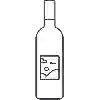
Domaine de VallouitCornas
This wine generally goes well with poultry, beef or game (deer, venison).
Food and wine pairings with Cornas
Pairings that work perfectly with Cornas
Original food and wine pairings with Cornas
The Cornas of Domaine de Vallouit matches generally quite well with dishes of beef, lamb or game (deer, venison) such as recipes of beef marengo "my mom" style, leg of lamb with garlic and rosemary or mymy's golden apples (squash).
Details and technical informations about Domaine de Vallouit's Cornas.
Discover the grape variety: Albillo mayor
Very old Spanish grape variety originating and cultivated in the upper Douro Valley - Ribera del Duero province of Burgos -. It is believed to be the result of a natural cross between the white Heben and a variety that is still unknown today. It should be noted that the synonym albillo is used for many other grape varieties, such as chasselas, muscat of Alexandria or albillo de Toro, verdejo or albillo de Nava, ... and it should not be confused with torrontés riojano. You can find the Albillo mayor in Italy, Spain, Portugal, Peru, Chile, Bulgaria, ... completely unknown in France.
Informations about the Domaine de Vallouit
The Domaine de Vallouit is one of of the world's great estates. It offers 26 wines for sale in the of Cornas to come and discover on site or to buy online.
The wine region of Cornas
The wine region of Cornas is located in the region of Rhône septentrional of Rhone Valley of France. Wineries and vineyards like the Domaine Thierry Allemand or the Domaine Thierry Allemand produce mainly wines red and white. The most planted grape varieties in the region of Cornas are Mourvèdre, Roussanne and Viognier, they are then used in wines in blends or as a single variety. On the nose of Cornas often reveals types of flavors of earthy, cream or citrus fruit and sometimes also flavors of perfume, sour cherry or lavender.
The wine region of Rhone Valley
The Rhone Valley is a key wine-producing region in Southeastern France. It follows the North-south course of the Rhône for nearly 240 km, from Lyon to the Rhône delta (Bouches-du-Rhône), near the Mediterranean coast. The Length of the valley means that Rhône wines are the product of a wide variety of soil types and mesoclimates. The viticultural areas of the region cover such a distance that there is a widely accepted division between its northern and southern parts.
The word of the wine: Venaison (taste of)
Wine aromas reminiscent of game (fur, leather, hare's belly).












